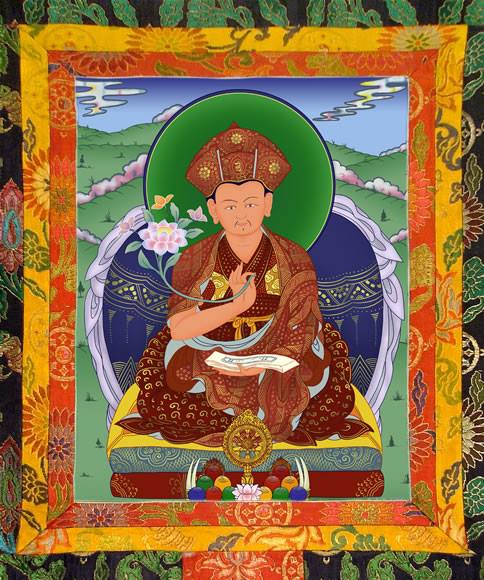Just focus on Buddha Amitabha. Just practicing Buddha Amitabha is more than enough for one’s entire life.
by Khenpo Tashi
*Amitabha’s Pureland is called Sukhavati (in Sanskrit language), Dewachen (Tibetan), and Ji-le (Chinese).
Before we begin, I doubt that reading this (in a blog) will have the same effect as receiving this teaching from a master. But anyway, I hope that by putting this here, this will bring focus on the importance of Amitabha Pureland Prayer.
Hearing the word “Amitabha”, or “Amitabha’s Pureland”, its prayer, or any short explanation on it but not giving rise to deep, unshakable faith, is a waste. Remember this, ok?
We will talk about Karma Chagme Rinpoche’s Aspiration To Be Born in Dewachen Prayer here.
The Four Preliminary Factors
There are four factors to be born in Dewachen:
- The Foundation or Basis – to clearly visualize the Dewachen pureland and the Buddhas and Bodhisattvas residing there
- Cause – Earning merit and purifying negative Karma
- Accompaniment – Generating the Mind of Enlightenment, Bodhicitta
- Conditioning factor – Praying the Wish to be Born in Dewachen
Please memorize these four factors. Keep them to heart. If we memorize them, it will be easy to recall them. In Tibetan, the four factors are called ten gyu drok kyen (Foundation, Cause, Accompaniment and Condition).
The Author and His Introduction
Karma Chakme (1613 – 1678AD, other name Raga Asha) is someone excellently special. His title is Khedrub in Tibetan, which means “scholar meditator” – someone who excelled in scholarship and also who is an accomplished meditator.

So, in the introduction of Amitabha Pureland Aspiration Prayer that he wrote, he said,
“Make this (prayer) your everyday main practice.
“Everyday” here literally means non-stop. Main practice is ‘thuk dam‘ in Tibetan, meaning, a practitioner’s heart practice, the one practice that you will never separate from….
Even if your hands are painful, or aching, even if it is difficult to copy this (by hand), even if you cannot write, still, write. The benefits of copying this are a lot and great.
Just to write this prayer has a lot of benefit. Nowadays, we can print, so no need to physically copy this text by hand. If you want to write it down, get a good book and write this prayer nicely.
I thought this aspiration prayer will benefit more people. If there is someone who wants to copy this, let them copy. There is nothing more beneficial than this.
Nowadays, our situation is different. In the ancient time, it is rare to find a copy of this Aspiration Prayer. If you have one, and I don’t have one, then I must write down by copying from you, because they could not print in the ancient time.
If you request a teaching from me, there is no Dharma teaching I can give that is more profound than this. Don’t ignore in any way, but use it and practice it. Since this is from the Sutra Tradition, one can recite it without oral transmission.”
See? Karma Chagme knew and practiced all the Sutras and Tantras. However, if you requested a teaching from him, this is his deepest and most profound teaching! See? This is how special and profound this prayer is.
In general, the Sutra, such as the Amitabha Sutra, if you want to recite, no need for the oral transmission. If this is Tantric, you must get the oral transmission.
Him saying that really means something, right?
The Main Aspiration Prayer
Title: Aspiration Prayer of Sukhavati (Tibetan: nam dak dechen zhing gyi monlam gye du shug so)
Actually, this prayer is divided into three parts:
- the visualization of Dewachen Pureland and the inhabitants there and the seven-branch offering
- aspiration prayers to be reborn in Dewachen Pureland
- description of Dewachen Pureland and dedication
First Part
Emaho! In the western direction, where the sun sets, beyond countless worlds and realms, slightly higher than the land of all noble beings, is the Pure Realm of Great Bliss, Sukhavati.
Even if it is not visible to the ordinary human eyes, but it can be seen by a perfectly clear mind.
He starts with “Emaho!” which means, “Woow, soooooooo great and astonishing!”
So, this is the beginning of the first part of the prayer, which is also the first factor, the foundation: Visualizing clearly the Pureland.
There are two foundations (of the first factor), right? Clearly visualizing a) the Dewachen Pureland and b) the Buddhas and Bodhisattvas residing in that land. So, who is the main Buddha residing in that Pureland? — Amitabha. On his right? — Bodhisattva Avalokiteshvara (or Kuan Yin). On his left? — Bodhisattva Vajrapani
In this realm is Buddha Amitabha, ruby in color and very bright…
So, he is very radiant, releasing so much light. With the protuberance on his head, 32 Physical Marks of the Supreme Buddha, his one face, two hands and so on. Then, there is a thousand-petalled lotus as his throne. Those with faith, he can gaze at us from afar. Dewachen is very far, right? But he can see those who have faith in him.
On his right is Bodhisattva Avalokiteshvara… on his left is Bodhisattva Vajrapani…
Two right hands mean these two Bodhisattvas’ right hands are in the gesture of giving safety, protection.
Then, the three of them are sitting like the king of mountains, Mt Meru. Then, they are surrounded by bright light. In Tibetan, lang nge lan ne lam mer shuk pe kor. The first, lang nge, is very clear and radiant. The second, lan ne, means sitting very stable, peaceful, immovable. lam me means very bright, releasing so much light like the sun, very blinding light.
Then, they are surrounded by a hundred thousand million Bodhisattvas who are fully ordained monks. All their bodies are gold, shining, like the three main Buddha and Bodhisattvas.
In Dewachen, there are monks and lay practitioners. But mainly, the monks are mentioned here (in the text). So, the monks there are wearing the three robes of a fully ordained monk, and they have a golden complexion.
… Devotedly bowing down, there is no such thing as near or far. I prostrate reverently with my three doors…
This is not just some ordinary bowing or prostrating. It is absolute respect, absolutely venerating, from the bottom of the mind. If you have this absolute veneration, the distance between the object of veneration (Buddha Amitabha) and the one venerating (oneself), instantly closes.
No more gap between them, becoming together instantly! The words ‘far’ and ‘near’ become the same here.
Continue to the second part.
